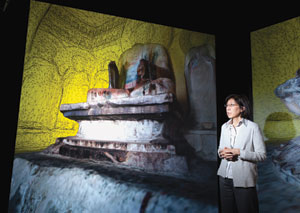Sacred art
By Lydialyle Gibson
Photography by Jason Smith
Hollowed out from limestone cliffs in northern China’s Hebei province, the Buddhist cave temples of Xiangtangshan—the “Mountain of Echoing Halls”—stood largely intact for nearly 1,500 years. Inside gleamed richly carved sculptures and altars, scrollwork, engraved scriptures, architectural details, and painted images in relief: masterpieces of the Northern Qi dynasty.
Then around 1909, the destruction began. China was in political turmoil—the last dynasty fell in 1911, replaced by the Chinese republic—and over the next several decades, the caves were plundered and damaged. In 1913, says Chicago art historian Katherine Tsiang, PhD’96, artifacts from the site began appearing in museums around the world. Not only were whole statues carted off and sold, but heads and hands and bits of relief were also chiseled away, leaving some caves practically empty. Despite that, even today seasonal festivals draw crowds of locals, Tisang says, and “people go up to the mountains to make offerings.”
Tsiang, associate director of the University’s Center for the Art of East Asia, began studying the Buddhist caves as a graduate student. In 2004 she and other researchers, including Chicago art historian Wu Hung, launched a project to find, archive, and analyze far-flung stone carvings from the early caves, dating from 550 to 577 AD. In all, the international team located about 100 objects and, whenever possible, tried to determine where they once stood in the caves by matching chisel marks and other details. They confirmed the results using 3D scans that Tsiang’s team made of cave interiors and sculptures that once inhabited them, lugging heavy equipment up mountainsides and into museums across the globe.

Some of those sculpted objects are part of a Smart Museum exhibit, cocurated by Tsiang: Echoes of the Past, up through January 16.
Among the displays is a “digital cave” (right, with Tsiang), an immersive reconstruction of one particular Xiangtangshan cave. Chicago visual-arts assistant professor Jason Salavon created it by merging 3D models of the cave with archival and contemporary photographs and then adding digital models of missing sculptures, shown in yellow. The result offers a simulation of the cave over time and with its artwork restored.
Return to top
